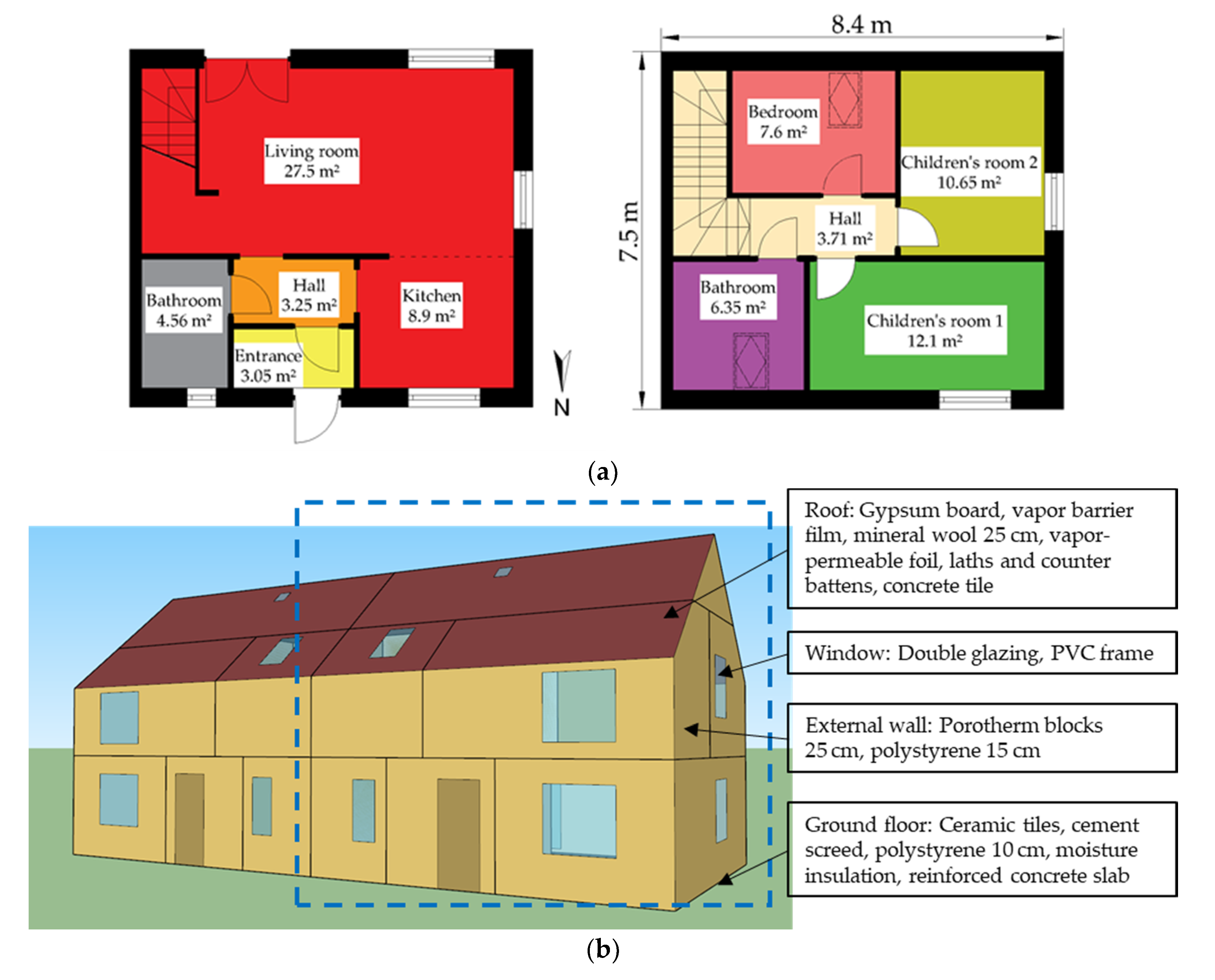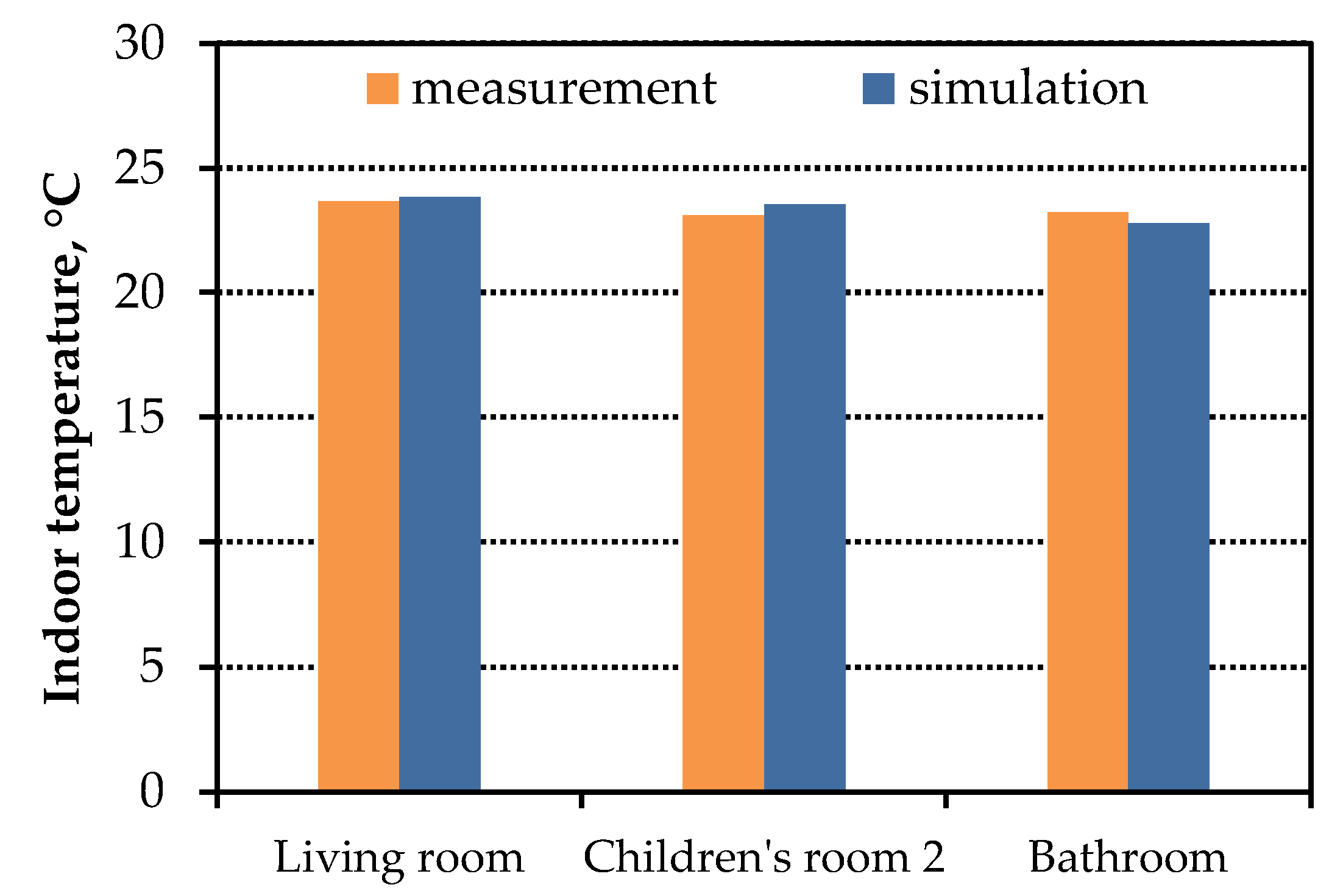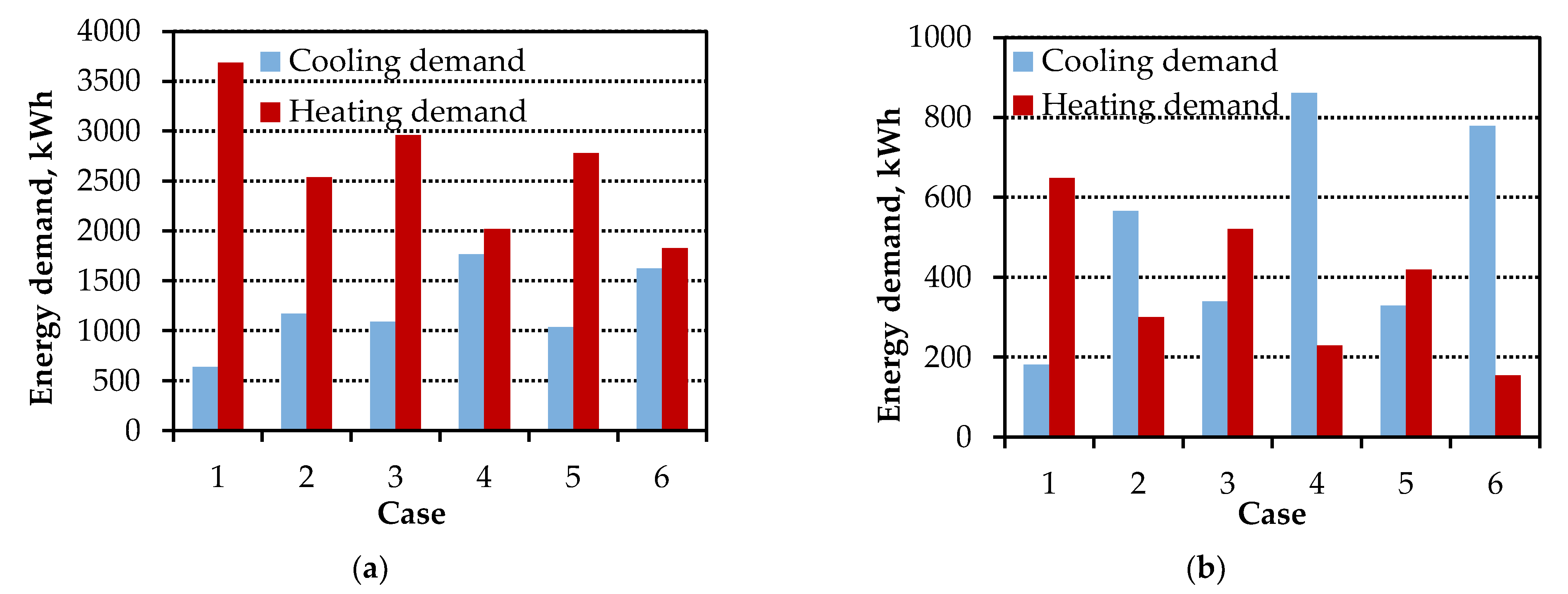Effects of Climate Change on Thermal Comfort and Energy Demand in a Single-Family House in Poland
Abstract
1. Introduction
2. Method
2.1. The Building
2.2. Thermal Model
2.3. Climate Data
2.4. Model Validation
2.5. Thermal Comfort Model
2.6. Case Studies
3. Results and Discussion
4. Conclusions
- With the current climatic conditions, in Poland (Central Europe, the Baltic Sea region) ventilative cooling is a good solution. It causes a sufficient reduction of energy demand to provide thermal comfort conditions in dwellings. Therefore, it is a lower-cost option than mechanical cooling. Moreover, it is environmentally friendly because it does not contribute to CO2 emissions to the atmosphere. Moreover, using only ventilative cooling can cause discomfort during only no more than 2% of the occupied time in rooms in the summer period. To obtain the lowest number of hours of discomfort, especially in summer, the air exchange rate significantly increased, up to 7 h−1. However, these cases are extreme. On the other hand, ventilative cooling has greater inertia of work, and it is not possible to reach the required internal temperature as quickly as in the case of mechanical cooling;
- In the future, global warming may render the ventilative cooling itself, without mechanical cooling ineffective. Especially in summer, residents may complain about excessively high indoor temperatures. In the most pessimistic variant, for a highly sunny room, the number of discomfort hours may be as much as 20% of the occupied time. A compromise solution would be to combine ventilative cooling with mechanical cooling. Mechanical cooling would only be turned on if ventilative cooling would not be able to provide comfort conditions, so that the costs of energy consumption would be as low as possible. However, such a solution would involve the introduction of the control system;
- Typical meteorological data, commonly use in energy analyses, are not actual. The results of 30-years-old data differed from current data. During several decades the climate has warmed up considerably. Therefore, particular attention should be given to the selection of climate data for building performance simulations. The obtained differences in the calculated heating demand between standard climate data and real data can reach even 8 kWh/m2;
- Very well-insulated buildings have more cooling demand however taking into account the sum of cooling and heating energy consumption, they generate lower operating costs compared to standard single-family houses; but in opposite in well-insulated houses without mechanical cooling thermal comfort conditions are significantly worse in current and future warmer climate. The use of insulation of passive building standard, causes greater overheating of the building, hence the higher the number of discomfort hours.
Author Contributions
Funding
Institutional Review Board Statement
Informed Consent Statement
Data Availability Statement
Acknowledgments
Conflicts of Interest
References
- Dodoo, A.; Gustavsson, L.; Bonakdar, F. Effects of Future Climate Change Scenarios on Overheating Risk and Primary Energy Use for Swedish Residential Buildings. Energy Procedia 2014, 61, 1179–1182. [Google Scholar] [CrossRef]
- Liu, C.; Coley, D. Overheating Risk of UK Dwellings Under a Changing Climate. Energy Procedia 2015, 78, 2796–2801. [Google Scholar] [CrossRef][Green Version]
- Ngarambe, J.; Yun, G.Y.; Santamouris, M. The use of artificial intelligence (AI) methods in the prediction of thermal comfort in buildings: Energy implications of AI-based thermal comfort controls. Energy Build. 2020, 211, 109807. [Google Scholar] [CrossRef]
- Yang, L.; Yan, H.; Lam, J.C. Thermal comfort and building energy consumption implications—A review. Appl. Energy 2014, 115, 164–173. [Google Scholar] [CrossRef]
- Oropeza-Perez, I.; Østergaard, P.A. Active and passive cooling methods for dwellings: A review. Renew. Sustain. Energy Rev. 2018, 82, 531–544. [Google Scholar] [CrossRef]
- Mirakhorli, A. Natural Ventilation in Residential Building in San Antonio Area. Available online: https://www.researchgate.net/publication/319162483_Natural_Ventilation_in_Residential_Buiding_An_EnergyPlus_simulation_study (accessed on 15 October 2021).
- Stazi, F.; Naspi, F.; Ulpiani, G.; DI Perna, C. Indoor air quality and thermal comfort optimization in classrooms developing an automatic system for windows opening and closing. Energy Build. 2017, 139, 732–746. [Google Scholar] [CrossRef]
- Grygierek, K.; Sarna, I. Impact of Passive Cooling on Thermal Comfort in a Single-Family Building for Current and Future Climate Conditions. Energies 2020, 13, 5332. [Google Scholar] [CrossRef]
- Brambilla, A.; Bonvin, J.; Flourentzou, F.; Jusselme, T. On the Influence of Thermal Mass and Natural Ventilation on Overheating Risk in Offices. Buildings 2018, 8, 47. [Google Scholar] [CrossRef]
- González, A.T.; Andrés-Chicote, M.; García-Ibáñez, P.; Velasco, E.; Rey-Martínez, F.J. Assessing the applicability of passive cooling and heating techniques through climate factors: An overview. Renew. Sustain. Energy Rev. 2016, 65, 727–742. [Google Scholar] [CrossRef]
- Artmann, N.; Manz, H.; Heiselberg, P. Climatic potential for passive cooling of buildings by night-time ventilation in Europe. Appl. Energy 2007, 84, 187–201. [Google Scholar] [CrossRef]
- Invidiata, A.; Ghisi, E. Impact of climate change on heating and cooling energy demand in houses in Brazil. Energy Build. 2016, 130, 20–32. [Google Scholar] [CrossRef]
- Kalvelage, K.; Passe, U.; Rabideau, S.; Takle, E.S. Changing climate: The effects on energy demand and human comfort. Energy Build. 2014, 76, 373–380. [Google Scholar] [CrossRef]
- Cui, Y.; Yan, D.; Hong, T.; Xiao, C.; Luo, X.; Zhang, Q. Comparison of typical year and multiyear building simulations using a 55-year actual weather data set from China. Appl. Energy 2017, 195, 890–904. [Google Scholar] [CrossRef]
- Kikumoto, H.; Ooka, R.; Arima, Y.; Yamanaka, T. Study on the future weather data considering the global and local climate change for building energy simulation. Sustain. Cities Soc. 2015, 14, 404–413. [Google Scholar] [CrossRef]
- Verichev, K.; Zamorano, M.; Carpio, M. Effects of climate change on variations in climatic zones and heating energy consumption of residential buildings in the southern Chile. Energy Build. 2020, 215, 109874. [Google Scholar] [CrossRef]
- Sabunas, A.; Kanapickas, A. Estimation of climate change impact on energy consumption in a residential building in Kaunas, Lithuania, using HEED Software. Energy Procedia 2017, 128, 92–99. [Google Scholar] [CrossRef]
- Tettey, U.Y.A.; Dodoo, A.; Gustavsson, L. Energy use implications of different design strategies for multi-storey residential buildings under future climates. Energy 2017, 138, 846–860. [Google Scholar] [CrossRef]
- SketchUp Documentation. Available online: https://sketchup.com.pl (accessed on 11 March 2020).
- US Department of Energy. Engineering Reference, EnergyPlus™ Version 9.4.0 Documentation; US Department of Energy: Washington, DC, USA, 2020. Available online: https://energyplus.net/sites/all/modules/custom/nrel_custom/pdfs/pdfs_v9.4.0/EngineeringReference.pdf (accessed on 23 February 2021).
- OpenStudio Documentation. Available online: http://nrel.github.io/OpenStudio-user-documentation (accessed on 28 February 2020).
- ASHRAE. ANSI/ASHRAE Standard 55. In Thermal Environmental Conditions for Human Occupancy; American Society of Heating, Refrigerating and Air-Conditioning Engineers (ASHRAE): Atlanta, GA, USA, 2017. [Google Scholar]
- Baranowski, A. Modelling of Natural Ventilation of Multi-Family Houses; Wydawnictwo Politechniki Śląskiej: Gliwice, Poland, 2007. (In Polish) [Google Scholar]
- Blaszczok, M.; Baranowski, A. Thermal improvement IN residential buildings in view of the indoor air quality—Case study for polish dwelling. Arch. Civ. Eng. Environ. 2018, 11, 121–130. [Google Scholar] [CrossRef]
- Ferdyn-Grygierek, J.; Baranowski, A.; Blaszczok, M.; Kaczmarczyk, J. Thermal Diagnostics of Natural Ventilation in Buildings: An Integrated Approach. Energies 2019, 12, 4556. [Google Scholar] [CrossRef]
- ASHRAE. 2001 ASHRAE Handbook Fundamentals, SI ed.; American Society of Heating, Refrigerating and Air-Conditioning Engineers: Atlanta, GA, USA, 2001. [Google Scholar]
- Herrera, M.; Natarajan, S.; Coley, D.A.; Kershaw, T.; Ramallo-González, A.P.; Eames, M.; Fosas, D.; Wood, M. A review of current and future weather data for building simulation. Build. Serv. Eng. Res. Technol. 2017, 38, 602–627. [Google Scholar] [CrossRef]
- Yassaghi, H.; Mostafavi, N.; Hoque, S. Evaluation of current and future hourly weather data intended for building designs: A Philadelphia case study. Energy Build. 2019, 199, 491–511. [Google Scholar] [CrossRef]
- Moazami, A.; Nik, V.M.; Carlucci, S.; Geving, S. Impacts of future weather data typology on building energy performance—Investigating long-term patterns of climate change and extreme weather conditions. Appl. Energy 2019, 238, 696–720. [Google Scholar] [CrossRef]
- IPCC. IPCC Special Report on Emissions Scenarios (SRES): Summary for Policymakers. In A Special Report of IPCC Working Group III Intergovernmental Panel on Climate Change; Intergovernmental Panel on Climate Change: Geneva, Switzerland, 2000. [Google Scholar]
- Intergovernmental Panel on Climate Change (IPCC). Available online: https://www.ipcc.ch (accessed on 14 February 2021).
- Escandón, R.; Suárez, R.; Sendra, J.J.; Ascione, F.; Bianco, N.; Mauro, G.M. Predicting the Impact of Climate Change on Thermal Comfort in A Building Category: The Case of Linear-type Social Housing Stock in Southern Spain. Energies 2019, 12, 2238. [Google Scholar] [CrossRef]
- IPCC. Climate Change 2007: The Physical Science Basis, Contribution of Working Group I to the Fourth Assessment Report of the Intergovernmental Panel on Climate Change; Solomon, S., Qin, D., Manning, M., Chen, Z., Marquis, M., Averyt, K.B., Tignor, M., Miller, H.L., Eds.; Cambridge University Press: New York, NY, USA, 2007. [Google Scholar]
- IPCC. Summary for Policymakers. In Climate Change 2013: The Physical Science Basis. Contribution of Working Group I to the Fifth Assessment Report of the Intergovernmental Panel on Climate Change; Stocker, T.F., Qin, D., Plattner, G.-K., Tignor, M., Allen, S.K., Boschung, J., Nauels, A., Xia, Y., Bex, V., Midgley, P.M., Eds.; Cambridge University Press: New York, NY, USA, 2013. [Google Scholar]
- Ministry of Investment and Development. Available online: https://www.gov.pl/web/archiwum-inwestycje-rozwoj/dane-do-obliczen-energetycznych-budynkow (accessed on 15 February 2021).
- Typical Meteorological Years and Statistical Climate Data for the Area of Poland for Energy Calculations of Buildings. Available online: https://dane.gov.pl/dataset/797,typowe-lata-meteorologiczne-i-statystyczne-dane-klimatyczne-dla-obszaru-polski-do-obliczen-energetycznych-budynkow (accessed on 20 December 2019).
- CCWorldWeatherGen Documentation. Available online: https://energy.soton.ac.uk/climate-change-world-weather-file-generator-for-world-wide-weather-data-ccworldweathergen (accessed on 16 February 2021).
- U.S. Department of Energy. Weather Data. EnergyPlus. Available online: https://energyplus.net/weather (accessed on 23 October 2019).
- University of Strathclyde Energy Systems Research Unit. ESRU Manual U02/1. In The ESP-r System for Building Energy Simulation; User Guide Version 10 Series; University of Strathclyde Energy Systems Research Unit: Glasgow, UK, 2002; Available online: http://www.esru.strath.ac.uk/Documents/ESP-r_userguide.pdf (accessed on 23 June 2020).
- IES. Available online: https://www.iesve.com/software (accessed on 19 February 2021).
- TAS. Available online: https://www.edsltas.com/ (accessed on 19 February 2021).
- Sarna, I.; Ferdyn-Grygierek, J.; Grygierek, K. Analysis of the model reliability for building thermal simulation. In Technical Solutions and Optimization as the Subject of Scientific Research, 1st ed.; Talarek, K., Maciag, K., Eds.; Wydawnictwo Naukowe TYGIEL: Lublin, Poland, 2020; pp. 193–203. ISBN 978-83-66489-24-0. (In Polish) [Google Scholar]
- ASHRAE. ASHRAE Guideline 14-2002: Measurement of Energy and Demand Savings; American Society of Heating, Refrigerating and Air-Conditioning Engineers: Atlanta, GA, USA, 2002. [Google Scholar]
- European Committee for Standardization. EU Standard EN16798-1:2019. In Energy Performance of Buildings—Ventilation for Buildings—Part 1: Indoor Environmental Input Parameters for Design and Assessment of Energy Performance of Buildings Addressing Indoor Air Quality, Thermal Environment, Lighting and Acoustics—Module M1-6; European Committee for Standardization: Brussels, Belgium, 2019. [Google Scholar]
- Barbadilla-Martín, E.; Martín, J.G.; Lissen, J.M.S.; Ramos, J.S.; Domínguez, S. Álvarez Assessment of thermal comfort and energy savings in a field study on adaptive comfort with application for mixed mode offices. Energy Build. 2018, 167, 281–289. [Google Scholar] [CrossRef]
- Nicol, J.F.; Humphreys, M.A. Adaptive thermal comfort and sustainable thermal standards for buildings. Energy Build. 2002, 34, 563–572. [Google Scholar] [CrossRef]
- Kaczmarczyk, J.; Ferdyn-Grygierek, J.; Baranowski, A. The impact of building parameters and way of operation on the operative temperature in rooms. Arch. Civ. Eng. Environ. 2018, 11, 107–114. [Google Scholar] [CrossRef]
- Polish Ministry of Infrastructure. Regulation of the Minister of Infrastructure of 12 April 2002 on the Technical Conditions That Should Be Met by Buildings and Their Location; Journal of Laws of the Republic of Poland No 75, Item. 690, (with Recast); Polish Ministry of Infrastructure: Warsaw, Poland, 2002. (In Polish) [Google Scholar]
- Państwowy Instytut Budownictwa Pasywnego. Available online: http://www.pibp.pl/ (accessed on 26 June 2020).
- Grygierek, K.; Ferdyn-Grygierek, J.; Gumińska, A.; Baran, Ł.; Barwa, M.; Czerw, K.; Gowik, P.; Makselan, K.; Potyka, K.; Psikuta, A. Energy and Environmental Analysis of Single-Family Houses Located in Poland. Energies 2020, 13, 2740. [Google Scholar] [CrossRef]
- Polish Ministry of Infrastructure. Regulation of the Minister of Infrastructure of 27 February 2015 on the Methodology for Calculating the Energy Performance of a Building or Part of A Building and Energy Performance Certificates; Journal of Laws of the Republic of Poland, Item. 376; Polish Ministry of Infrastructure: Warsaw, Poland, 2015. (In Polish) [Google Scholar]










| Heat Gain | Value | Occurrence |
|---|---|---|
| Occupants | 126 W (sensible + latent) | All zones schedule |
| Electric cooker | 300 W | Living room schedule |
| Fridge | 150 W | Kitchen clockwise |
| TV set | 50 W | Living room schedule |
| Computer | 100 W | Children’s rooms schedule |
| Steaming hot water | 913 W (latent fraction of 0.89) | Bathrooms schedule |
| Lighting | 2 W/m2 | Switching on and off controlled using the function “DaylightingControl”, the light source switched on depending on the lighting intensity of the room |
| Building Zone | Error |
|---|---|
| Living room with open kitchen | NMBE = 1%; CVRMSE = 3% |
| Children’s room 2 | NMBE = 2%; CVRMSE = 3% |
| Bathroom on 1st floor | NMBE = 2%; CVRMSE = 3% |
| Parameter | Case | ||||||||||||
|---|---|---|---|---|---|---|---|---|---|---|---|---|---|
| 1 | 2 | 3 | 4 | 5 | 6 | 7 | 8 | 9 | 10 | 11 | 12 | ||
| Cooling System | mechanical | + | + | + | + | + | + | ||||||
| passive | + | + | + | + | + | + | |||||||
| Climate | TMY | + | + | + | + | ||||||||
| real 2018 | + | + | + | + | |||||||||
| future | + | + | + | + | |||||||||
| Building Insulation | standard | + | + | + | + | + | + | ||||||
| passive | + | + | + | + | + | + | |||||||
| Result | Mechanical Cooling Cases 1–6 | Passive Cooling Cases 7–12 |
|---|---|---|
| Heating demand | YES | YES |
| Cooling demand | YES | NO |
| Number of discomfort hours | NO | YES |
| Case | Living Room | Bedroom | Children’s Room 1 | Children’s Room 2 |
|---|---|---|---|---|
| 7 | 2.5 (0.1%) | 8.5 (0.3%) | 19.8 (0.5%) | 2.3 (0.1%) |
| 8 | 0.0 (0.0%) | 12.3 (0.4%) | 8.8 (0.2%) | 2.3 (0.1%) |
| 9 | 2.0 (0.1%) | 21.0 (0.7%) | 5.5 (0.1%) | 3.0 (0.1%) |
| 10 | 6.5 (0.2%) | 38.7 (1.2%) | 4.0 (0.1%) | 3.0 (0.1%) |
| 11 | 2.8 (0.1%) | 88.8 (2.8%) | 53.3 (1.2%) | 58.5 (1.4%) |
| 12 | 102.8 (3.7%) | 146.5 (4.6%) | 91.5 (2.1%) | 92.0 (2.2%) |
| Case | Living Room | Bedroom | Children’s Room 1 | Children’s Room 2 |
|---|---|---|---|---|
| 7 | 0.8 (0.1%) | 7.8 (1.0%) | 19.0 (1.8%) | 1.5 (0.1%) |
| 8 | 0.0 (0.0%) | 11.3 (1.4%) | 7.5 (0.7%) | 2.3 (0.2%) |
| 9 | 1.5 (0.2%) | 20.0 (2.5%) | 5.0 (0.5%) | 2.0 (0.2%) |
| 10 | 6.0 (0.9%) | 37.5 (4.7%) | 3.0 (0.3%) | 2.5 (0.2%) |
| 11 | 0.3 (0.0%) | 88.8 (11.1%) | 50.8 (4.7%) | 57.8 (5.4%) |
| 12 | 102 (14.6%) | 145 (18.1%) | 90.8 (8.4%) | 92.8 (8.6%) |
| Case | Mean (Annual), h−1 | Max (Annual), h−1 | Mean (June–August), h−1 | Max (June–August), h−1 |
|---|---|---|---|---|
| 1 | 0.1 | 0.2 | 0.1 | 0.1 |
| 2 | 0.1 | 0.2 | 0.1 | 0.1 |
| 3 | 0.1 | 0.2 | 0.1 | 0.1 |
| 4 | 0.1 | 0.2 | 0.1 | 0.1 |
| 5 | 0.1 | 0.2 | 0.1 | 0.1 |
| 6 | 0.1 | 0.2 | 0.1 | 0.1 |
| 7 | 0.2 | 5.0 | 0.4 | 4.1 |
| 8 | 0.3 | 5.2 | 0.6 | 4.2 |
| 9 | 0.3 | 4.0 | 0.5 | 3.0 |
| 10 | 0.5 | 7.3 | 0.9 | 5.7 |
| 11 | 0.3 | 4.9 | 0.5 | 3.6 |
| 12 | 0.4 | 3.8 | 0.7 | 3.1 |
| Case | Heating Costs, EUR | Cooling Costs, EUR | Total Costs, EUR |
|---|---|---|---|
| 1 | 195 | 13 | 208 |
| 2 | 134 | 24 | 158 |
| 3 | 156 | 23 | 179 |
| 4 | 107 | 37 | 143 |
| 5 | 147 | 22 | 168 |
| 6 | 96 | 34 | 130 |
| 7 | 199 | 0 | 199 |
| 8 | 140 | 0 | 140 |
| 9 | 161 | 0 | 161 |
| 10 | 115 | 0 | 115 |
| 11 | 151 | 0 | 151 |
| 12 | 103 | 0 | 103 |
Publisher’s Note: MDPI stays neutral with regard to jurisdictional claims in published maps and institutional affiliations. |
© 2021 by the authors. Licensee MDPI, Basel, Switzerland. This article is an open access article distributed under the terms and conditions of the Creative Commons Attribution (CC BY) license (https://creativecommons.org/licenses/by/4.0/).
Share and Cite
Ferdyn-Grygierek, J.; Sarna, I.; Grygierek, K. Effects of Climate Change on Thermal Comfort and Energy Demand in a Single-Family House in Poland. Buildings 2021, 11, 595. https://doi.org/10.3390/buildings11120595
Ferdyn-Grygierek J, Sarna I, Grygierek K. Effects of Climate Change on Thermal Comfort and Energy Demand in a Single-Family House in Poland. Buildings. 2021; 11(12):595. https://doi.org/10.3390/buildings11120595
Chicago/Turabian StyleFerdyn-Grygierek, Joanna, Izabela Sarna, and Krzysztof Grygierek. 2021. "Effects of Climate Change on Thermal Comfort and Energy Demand in a Single-Family House in Poland" Buildings 11, no. 12: 595. https://doi.org/10.3390/buildings11120595
APA StyleFerdyn-Grygierek, J., Sarna, I., & Grygierek, K. (2021). Effects of Climate Change on Thermal Comfort and Energy Demand in a Single-Family House in Poland. Buildings, 11(12), 595. https://doi.org/10.3390/buildings11120595








